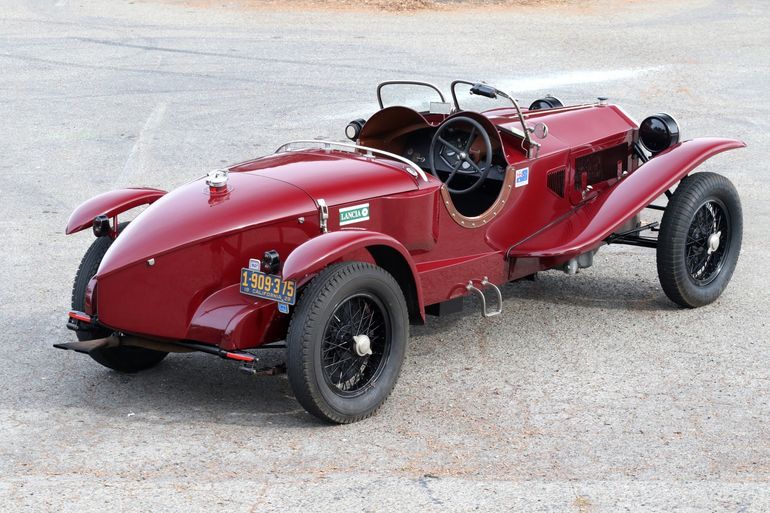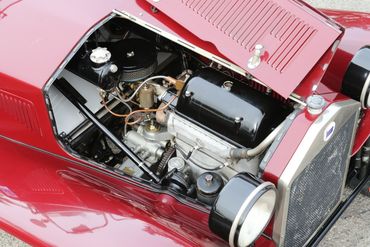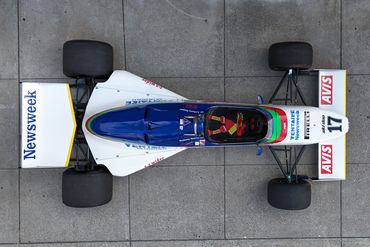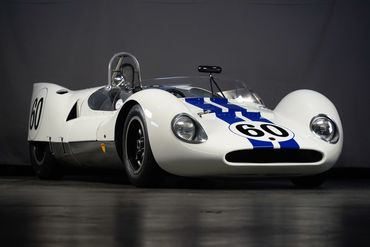Sold
SOLD 12/19
1928 Lancia
Lambda with Casaro Mille Miglia Coachwork
Desirable Casaro Mille Miglia Configuration. 3 Litre Engine Supplying Ample Power. Ideal For Driving Events.
- VIN20908
- Exterior ColorDark Red
- Interior ColorBrown Leather
- Mileage26875 Miles (TMU)
- Engine3.0 Litre 4-Cylinder
- Engine no.10842
- Transmission4-Speed
- StatusSold
- StockFJ1300
Description
1928 Lancia Lambda with Casaro Mille Miglia Coachwork
s/n 20908, Engine no. 10842
Dark Red with Brown Leather Interior
Founded in 1906 by Fiat racecar drivers Vincenzo Lancia and Claudio Fogolin, the Torino, Italy based company would build their first cars in 1908. Though development was challenging for the fledgling company, by 1922 the ground-breaking engineering and design of the Lambda series set a new standard in automobile manufacturing. The key to these advances was Vincenzo Lancia; a highly gifted driver with a unique combination of mechanical prowess, engineering capabilities, and design skills. Strikingly modern for the era, the Lambda featured the first integrated unit construction steel monocoque body and chassis, which allowed the central driveshaft tunnel to function as the main structural unit. This feature created a strong central structure without the weight of heavy steel frame rails and lowered the center of gravity by placing occupants beside the driveshaft tunnel instead of on top.
Further advanced features included independent front suspension and sliding pillar with coil springs that utilized Lancia-developed telescopic shock absorbers. The rear suspension featured semi-elliptic springs and friction dampers. Power was also innovative with a uniquely configured single overhead cam narrow angle V4, initially of 2121 cc. Remarkably robust yet light and nimble, the Lambda became known for its superb handling and broad powerband, which not only attracted sporting customers, but further proved its prowess in racing with successes in the Mille Miglia and other road racing events.
In 1928, Lancia prepared three new 8th series 221 short wheelbase chassis, fitted with aluminum Casaro bodies. These three cars were the only examples of their type. All three were subsequently entered in the Mille Miglia. Although driver Luigi Gismondi was leading the pack with just under 200 miles to the finish, he spun out of control and crashed. The 1928 win went to Alfa Romeo. The two remaining Lancia factory cars finished 3rd and 9th place. Sadly, for posterity, none of these three original Mille Miglia cars exist today. If any of the three original examples had survived in the ensuing 90 years, they would surely place amongst the most valuable pre-war automobiles ever built.
With the goal of achieving the most accurate depiction of these long lost original Mille Miglia cars, this particular car was professionally constructed to emulate the original three Mille Miglia examples regrettably lost to the perils of history. In order to construct such an important car, an authentic Lancia chassis was located to begin the process. Research indicates that 8th series Lancia chassis were constructed beginning with chassis number 18601, with all three of the Mille Miglia cars completed within serial numbers 18604-18612.
This car, chassis number 20908, was assembled at Lancia in 1929, likely between March and May 1929. The completed car, outfitted with engine number 10842, was commissioned by Donald Wright by Queens Counsel Lynton Morris. In order to create the most accurate version of the original Mille Miglia cars, this chassis was shortened to the same length as the original three cars. Renown craftsman Brian Hawke was then commissioned to carefully craft the original Casaro aluminum body using images referenced from early period photographs and period specifications. During construction, the original engine was retained, and a Tipo 109 gearbox corresponding to April 1925 manufacturing date, using aluminum case number 2715, corresponding to a 1929 date of manufacture, were assembled and installed in the shortened chassis. A Lancia rear spring crossmember, number 15786, corresponding to July 1926 manufacture, was also fit to the chassis. Once these rare and highly desirable components were installed, the alloy body panels were sorted for final fit and detailing. The Spyder Tipo Corsa configuration was beautifully formed over the Lancia chassis using period correct components, Lancia details, and proper hardware. Since its construction, this Lancia Lambda has been recognized by many experts as a highly accurate and correctly detailed example emulating the Mille Miglia Casaro bodied cars. The engine, with increased displacement to 3 liters, utilizes a “Wright” cylinder casting section, which delivers wonderful additional power to an already fantastic driving car.
Today this Lancia Lambda is a beautiful expression of automotive history, thoughtfully conceived to represent the brilliance and visceral excitement of pre-war Italian racing and engineering prowess. After completion of the build, the car was enjoyed for decades by premier collector and enthusiast Peter Giddings. During his ownership Mr. Giddings entered this Lancia in many events including the 2002 and 2005 Australian Grand Prix, which is documented in the CSRG logbook accompanying the car. Consistent with these years of joyful use, the finish, while still glossy, is a tribute to the sporting nature of the original, reflected in the gravel-dappled rear fender tips, lightly speckled facia, and satin finishes adorning the headlights, grille, and other trim. Many prewar cars feature fully restored components with new paint and plating, but those finishes often defy the ambiance of the era. Not so with this wonderful Lancia, imbued by years of rewarding driving, the aura is a proud ambassador to the three seminal Mille Miglia progenitors no longer with us today.
In addition to the delicate areas of weathering, authentic details include beautifully finished headlights, crafted mechanical fasteners, exposed fuel filler, tilting split windscreen, and correctly painted wire wheels. These handsome details are all the more delightful as part of the historically crafted Casaro coachwork. Here the legacy of the Spyder Corsa lines defy the typical designs of the 1920s with a low cowl line, elegant fenders, and open barchetta configuration. Proportions are perfectly balanced yet decidedly sporting. Every element of construction and presentation has been thoughtfully engaged with both accuracy and refinement in keeping with the traditions of original Lancia construction.
Inside the cockpit, the rich brown leather interior has been configured with care and elegance, tending to authentic details once again just as the exterior crafting boasts. Proper materials and construction include leather seating that also decorates the tops of the entry scallops as they drape into the body. The interior has just the right amount of comfortable “give” to the finishes, including a worn interior side panel gleefully carved out by the eagerly used foot upon the accelerator. A handsome array of instrumentation finished with correct dials and bezels display all major mechanical requirements needed for sporting use. The black steering wheel, open gearbox casting, and hand brake lever perfectly convey the early period competition flavor of this Lancia.
Opening either side of the hinged hood, the engine is revealed in all its early period glory. The unique engine design and layout features rear mounted intake and exhaust accompanied by finned aluminum casting covers and handsome aluminum structural castings. Various fuel and oil lines, and linkages are all in keeping with the era. All finishes have been properly rendered, but time and care now present these features with dignity and purpose. Underneath the car, finishes and coatings continue to support the dedicated stewardship afforded since construction.
Climbing into the cockpit via the cast aluminum foot stirrup, the seating position is commanding yet comfortable. Controls are easily in reach and the starting procedure is surprisingly simple when compared to cars of this period. The engine comes to life with a resonant idle and excellent throttle response. The gearbox is easily engaged, and the clutch takes up easily as the road opens up before you. The long hood might seem daunting, but the large steering wheel and light construction make for excellent handling at speed. Power is smooth, consistent, and road manners are delightful in every respect. Fantastically sorted, particularly when pushed a bit, the car responds with confidence, delivering all that one might expect from a pre-war driving experience, with none of the frailty other cars of this period exhibit. While one might expect steering and braking to be a bit challenging given the era, the weight of the car is perfectly balanced, tracking diligently, offering ample braking power.
Ready for enthusiastic ownership, continuing in the legacy of the long-term current ownership, this beautifully constructed Lancia Lambda is accompanied by an original, rare and beautifully patinated Lambda instruction manual, a copy of a 7th Series Lancia parts manual, and a box of miscellaneous spare parts.
Prepared in every respect by a cadre of Lancia experts and long cared-for under enthusiast stewardship, this beautifully constructed Lancia Lambda is now ready to embark on the next ownership journey. An ideal car for many important concours and tours, this example is ready to deliver years of continued enjoyment seen through the historic lens of the Mille Miglia, as a proud ambassador of the Lancia name.
The above vehicle information is complete and accurate to the best of our knowledge at the time it is posted to this website. Corrections or additional information is always appreciated. All advertised prices exclude government fees and taxes, any finance charges, any dealer document preparation charge, and any emission testing charge. Vehicles are subject to prior sale. All advertised to be true but not guaranteed. We assume no liability for errors or omissions.
Inquire About This Car
Fantasy Junction • 510-653-7555 • 1145 Park Ave, Emeryville, CA 94608





